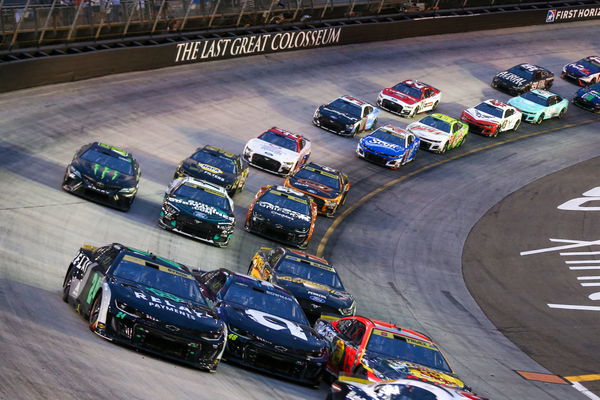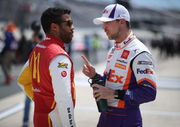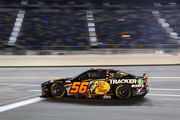
USA Today via Reuters
Sep 16, 2023; Bristol, Tennessee, USA; NASCAR Cup Series driver William Byron (24) and driver Martin Truex Jr. (19) and driver Alex Bowman (48) during the Bass Pro Shops Night Race at Bristol Motor Speedway. Mandatory Credit: Randy Sartin-USA TODAY Sports

USA Today via Reuters
Sep 16, 2023; Bristol, Tennessee, USA; NASCAR Cup Series driver William Byron (24) and driver Martin Truex Jr. (19) and driver Alex Bowman (48) during the Bass Pro Shops Night Race at Bristol Motor Speedway. Mandatory Credit: Randy Sartin-USA TODAY Sports
Over the course of its long and illustrious history, NASCAR has prided itself on a great many things. One of those things was short-track racing. Back in the day, short tracks were all the rage as fans flocked by their thousands to see the best drivers in the country run super close to one another at high speeds. However, times have changed and short-track racing isn’t a crown jewel for the stock car racing organization anymore, especially ever since the Next-Gen came into existence. But it seems there is hope for the future.
As the Next-Gen cars came, racing at intermediate tracks like Kansas and Charlotte saw a lot of improvement. However, what got affected were the short tracks and road courses, especially the former. The biggest issue that became evident was that passing had become almost impossible. Now it’s common knowledge that short tracks are known for being difficult to perform overtakes, but making it almost impossible? That’s just boring.
ADVERTISEMENT
Article continues below this ad
Phoenix Raceway saw multiple slide jobs and passes after years in NASCAR
After months of fans and insiders calling for a change, NASCAR finally came out with their new aero package specifically designed to make racing better on short tracks. It was first seen in action on Sunday’s race in Phoenix and it’s safe to say that it has exceeded expectations. A lot of the drivers tuned the hype down about the package, but there was a lot of difference under racing conditions. Perhaps the NASCAR fans have become used to seeing the Next-Gens cook up a snoozefest at places like Bristol and Martinsville, and even a slight change felt like a breath of fresh air.
Can more improvements be made? Yes, of course, but for a first-time fix, the package worked pretty well. For the first time in a very long time, race fans saw Cup Series driver slide their cars from the bottom lane to the top with a lot more ease than before as they completed the passes. There were several incidents of contact as well which proved that the racing was not boring.
To give you an interesting stat, five different drivers led more than 50 laps in Sunday’s Cup race. This kind of competition and level playing field was hard to come by with the earlier package where overtaking was a pain.
Just take race winner Christopher Bell for example and think about just how many cars he had to pass to win the event. The driver of the #20 car started the race in P13 and by the time the checkered flag fell, he had recovered from even further down in the final stage to finish P1, making countless passes and slide jobs in the process. The aero package had a big role to play in his performance, but it was not without its disadvantages. Racing in traffic was still a pain in the backside, and Bell found that out well enough.
Phoenix 🏁 🏆- only the beginning 👊🏼 #teamtoyota pic.twitter.com/YTltpb6aI1
— Christopher Bell (@CBellRacing) March 11, 2024
However, once the field started to string out, the Joe Gibbs Racing star picked his competitors off one by one. And he was not the only one passing others on the track. Several racers did the same. One of the more memorable slide jobs was that of Brad Keselowski when he tried to get past Ross Chastain with just 13 laps to go. That move would have been way too risky and almost impossible to even try a year ago.
Now, one thing to note here is that the Phoenix Raceway is not a real short track. It’s very close to being one in terms of length but it isn’t. So the first taste of the aero package on a short track will be seen next weekend when the Cup Series goes to Bristol. And quite frankly, there’s reason to be excited.
Read More: Christopher Bell Overcame a “Lot of New” to Hand Toyota Their First Win of the Season
Trending
Understanding the smaller floor design in the new aero package
To explain how this aero package has made racing better, one has to look back at the main problems NASCAR has been having with the Next-Gen on short tracks. These cars are low on horsepower so they can’t blast ahead in front of their competitors. What the drivers rely on to pass on short tracks is the car’s maneuverability when sliding around and passing others from the bottom of the track.
This used to be almost impossible earlier as the Next-Gen used to generate far too much downforce to slide around with ease. And that’s where the new aero package comes in. The changes have been mainly made to the floor of the car. NBC’s Steve Letarte explained it best in a video uploaded by NASCAR. The size of the floor has gone down drastically, both in terms of length and width, which reduces downforce and allows the driver to slide the back of their car a lot easier. Now it’s important to remember that the floor plays a substantial role in generating downforce and even the slightest change would affect it.
What NASCAR did was a significant change and as a result, it turned out that there was too little downforce and cars would struggle for grip if that’s the case. There needs to be this fine balance between both aspects. Therefore, they increased the size of the rear spoiler by an inch. Initial responses after the practice sessions were mixed, but the consensus was that there was not much difference in terms of feel. But that was not the case under racing conditions.
ADVERTISEMENT
Article continues below this ad
However, to suggest that it is a complete fix to NASCAR’s short-track racing problem would be unwise. There are still a lot of issues that need to be sorted. The lower horsepower, for example, negatively affects the throttle response, making it extremely tough for drivers to speed up or slow down in the space of a few seconds. Denny Hamlin mentioned before the race that the aero package was only a 10% improvement and Sunday’s race was not exactly on a short track.
ADVERTISEMENT
Article continues below this ad
It will be interesting to see how the cars run in Bristol next weekend. If Hamlin’s comments are to be believed and a 10% improvement made that much of a difference, imagine what 100% would look like. Hopefully, we’re all headed for a better era of short-track racing in NASCAR.
Read More: Joe Gibbs Gave His Verdict on Toyota’s New Camry After JGR Had a Weekend to Remember
ADVERTISEMENT
ADVERTISEMENT
ADVERTISEMENT
ADVERTISEMENT






